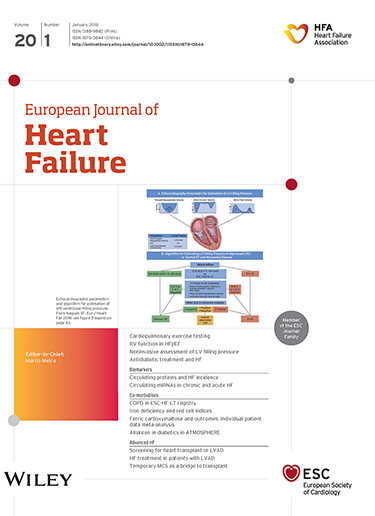基因型-表型关联对扩张型心肌病预后的影响。
IF 10.8
1区 医学
Q1 CARDIAC & CARDIOVASCULAR SYSTEMS
引用次数: 0
摘要
目的:扩张型心肌病(DCM)在高达40%的患者中具有单基因病因。了解DCM的基因型-表型关联谱对于风险分层和个性化治疗至关重要。我们的目的是(i)表征基因型特异性特征,(ii)评估基于表型的聚类是否反映潜在的基因型,以及(iii)比较基于基因型和基于表型的方法的预后价值。方法与结果对534例(可能)致病变异的DCM患者进行多中心队列研究,按基因型(基因型优先法)分组,按临床表型(表型优先法)聚类。我们比较了临床特征,确定了基因型-表型关联,并评估了结果,包括全因死亡率、心力衰竭住院、心脏移植和恶性室性心律失常。采用基因型优先方法,发现10个基因存在显著的基因型-表型关联。FLNC、LMNA、DSP和PLN变异与心律失常有关。BAG3、TNNT2、DMD和TTN与心脏容量增加和左室射血分数(LVEF)降低相关。聚类鉴定出四个表型簇:(1)年轻,LVEF中度降低;(2)心律失常,LVEF中度降低;(3)低LVEF;(4)心律失常,低LVEF。表型簇与基因型之间没有明显的相关性。基因型优先方法显示,LMNA、FLNC和BAG3变异具有心力衰竭和心律失常不良后果的最高风险。表型优先的方法表明,第3和第4组与最差的预后相关。总的来说,基因型是结果的最强预测因子。结论遗传型DCM患者表现出临床和遗传异质性。与表型优先的方法相比,基于基因型的风险分层更准确,强调了在DCM患者中进行广泛遗传筛查的重要性。此外,基因特异性风险预测应该在目前的遗传DCM患者管理指南中变得更加突出。本文章由计算机程序翻译,如有差异,请以英文原文为准。
Impact of genotype-phenotype associations on prognosis in dilated cardiomyopathy.
AIMS
Dilated cardiomyopathy (DCM) has a monogenic aetiology in up to 40% of patients. Understanding the spectrum of genotype-phenotype associations in DCM is crucial for risk stratification and personalized treatment. We aimed to (i) characterize genotype-specific features, (ii) evaluate whether phenotype-based clustering reflects underlying genotype, and (iii) compare the prognostic value of genotype- versus phenotype-based approaches.
METHODS AND RESULTS
A multicentre cohort of 534 DCM patients with a (likely) pathogenic variant were grouped by genotype (genotype-first approach) and clustered by clinical phenotype (phenotype-first approach). We compared clinical characteristics, identified genotype-phenotype associations, and evaluated outcomes, including all-cause mortality, heart failure hospitalization, heart transplantation, and malignant ventricular arrhythmias. Using the genotype-first approach, significant genotype-phenotype associations were found for 10 genes. FLNC, LMNA, DSP, and PLN variants were linked to arrhythmias. BAG3, TNNT2, DMD, and TTN were associated with increased cardiac volumes and decreased left ventricular ejection fraction (LVEF). Clustering identified four phenotypic clusters: (1) young, moderately reduced LVEF; (2) arrhythmias, moderate reduced LVEF; (3) low LVEF; (4) arrhythmias, low LVEF. There were no clear correlations between phenotypic clusters and genotype. The genotype-first approach showed that LMNA, FLNC, and BAG3 variants had the highest risk for heart failure and arrhythmogenic adverse outcomes. The phenotype-first approach indicated that clusters 3 and 4 were associated with the worst prognosis. Overall, genotype was the strongest predictor of outcome.
CONCLUSIONS
Patients with a genetic form of DCM exhibit clinical and genetic heterogeneity. Genotype-based risk stratification is more accurate compared to a phenotype-first approach, highlighting the importance of broad genetic screening among patients with DCM. Additionally, gene-specific risk prediction should become more prominent in current guidelines on management of genetic DCM patients.
求助全文
通过发布文献求助,成功后即可免费获取论文全文。
去求助
来源期刊

European Journal of Heart Failure
医学-心血管系统
CiteScore
27.30
自引率
11.50%
发文量
365
审稿时长
1 months
期刊介绍:
European Journal of Heart Failure is an international journal dedicated to advancing knowledge in the field of heart failure management. The journal publishes reviews and editorials aimed at improving understanding, prevention, investigation, and treatment of heart failure. It covers various disciplines such as molecular and cellular biology, pathology, physiology, electrophysiology, pharmacology, clinical sciences, social sciences, and population sciences. The journal welcomes submissions of manuscripts on basic, clinical, and population sciences, as well as original contributions on nursing, care of the elderly, primary care, health economics, and other related specialist fields. It is published monthly and has a readership that includes cardiologists, emergency room physicians, intensivists, internists, general physicians, cardiac nurses, diabetologists, epidemiologists, basic scientists focusing on cardiovascular research, and those working in rehabilitation. The journal is abstracted and indexed in various databases such as Academic Search, Embase, MEDLINE/PubMed, and Science Citation Index.
 求助内容:
求助内容: 应助结果提醒方式:
应助结果提醒方式:


